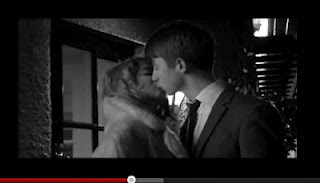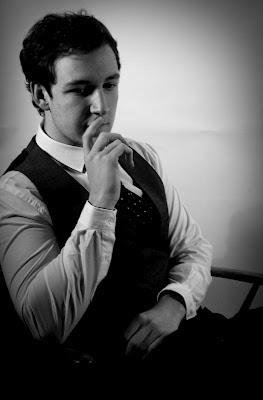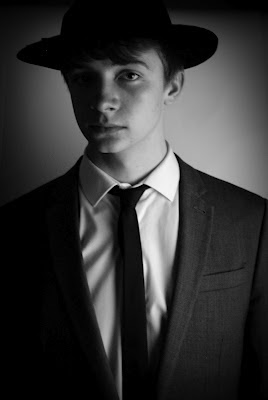We have completed putting the whole film into sequence and editing it together now. One of my favourite parts of the editing so far is the arration at the beginning, when Detective Carter is at his desk searching through the photographs. The soft minor tone in music underlying the strong, american narration in my opinion makes the perfect opening for our film. It's exactly how i'd
imagined it would be, and the rough edge in the voice makes it so much more inticing - it's as if we feel he is a troubled protagonist and it therefore draws us into the story. The mystery we want is created however by us not showing the character's face straight away, developing a secretive and suspenseful atmosphere.
The typical image of film noir is also quickly introduced because of the hat being immediately visible and the black/white use of colour.

We used the tool 'voiceover' in final cut on the Apple Macs we are using to edit and recorded our scripted words to overlay the beginning of our film. Ed did a fantastic job of it and sounded just like we wanted him to. He has a strong male voice and this definitely comes across well in the recording. It took a couple of recordings because of stumbles over words and correctly selecting it's positioning over clips so the timing was right, but really did work well.

During the outside part of the restaurant scene (scene 3) wind and cars is the priority sound in the clip. In order to make sure our actors were clearly understood and their words had the desired effect we needed to record the lines again using the voiceover tool due to the unwanted sounds on the camera. We made sure their lines synced in with the on screen words perfectly, and also that their voices were well pronounced. The scene most certainly works better now that the voiceover has been done.
The last voiceover we did was the one for the office scene. I knocked on the desk, Toby said
'Come In' and Ellen said 'Hello Sir' to fill in the part of the Office scene (scene 1) that when we played back during editing we felt weren't clear enough. It worked well and as it is only a small recording doesn't make too much difference to the rest of the clip but allows our audience to hear it much better.
Unfortunately the office scene was filmed in a tight time slot as we borrowed a teachers office, and the people around were loud and caused us a problem in the editing. Some of the script had to be cut out because of mistakes like sound errors, but after trying to cut it all together it ended up having to be quite jumpy, and unfortunately does not have the effect we desired. Some of the script has a great deal of power, such as the close up on Bonnie when she says 'a big problem' but learning from this, we must ensure to capture a lot more extra footage than we did this time.
We added a 'ripple' effect after the introductory scene and before the last scene where the detective says 'This isn't over' to make sure audiences could easily distinguish between the flashback and present tense within the story. Even though this isn't common in film noir films we felt it was necessary as the whole thing is in black and white and only words could otherwise help the understanding of the switch.
In the gun shooting scene we recorded gun shots sounds off the internet on Ellen's iphone and then played them back whilst recording on Final Cut Express to fit them into the sequence perfectly. The sounds aren't overwhelmingly loud but they sound powerful and of course we know by Bobby's reaction that he has been shot, no need to show actual gunshots.
In the above left photograph, Bobby can be seen saying the number '4' as part of the script, "5,4,3,2," but what we did was filmed the script twice from two different angles, and overlapped the line so that the sound works perfectly, and a better variety in the scene was created. It works really well I feel.























